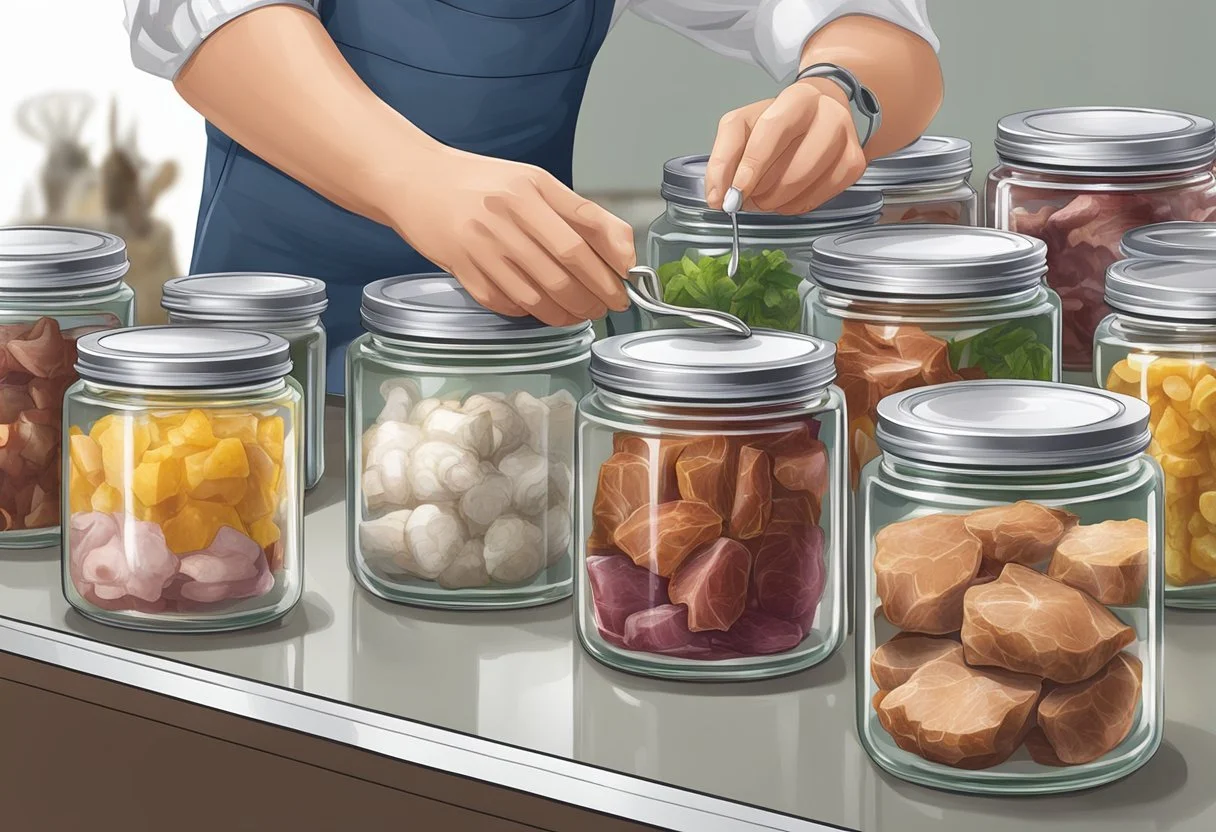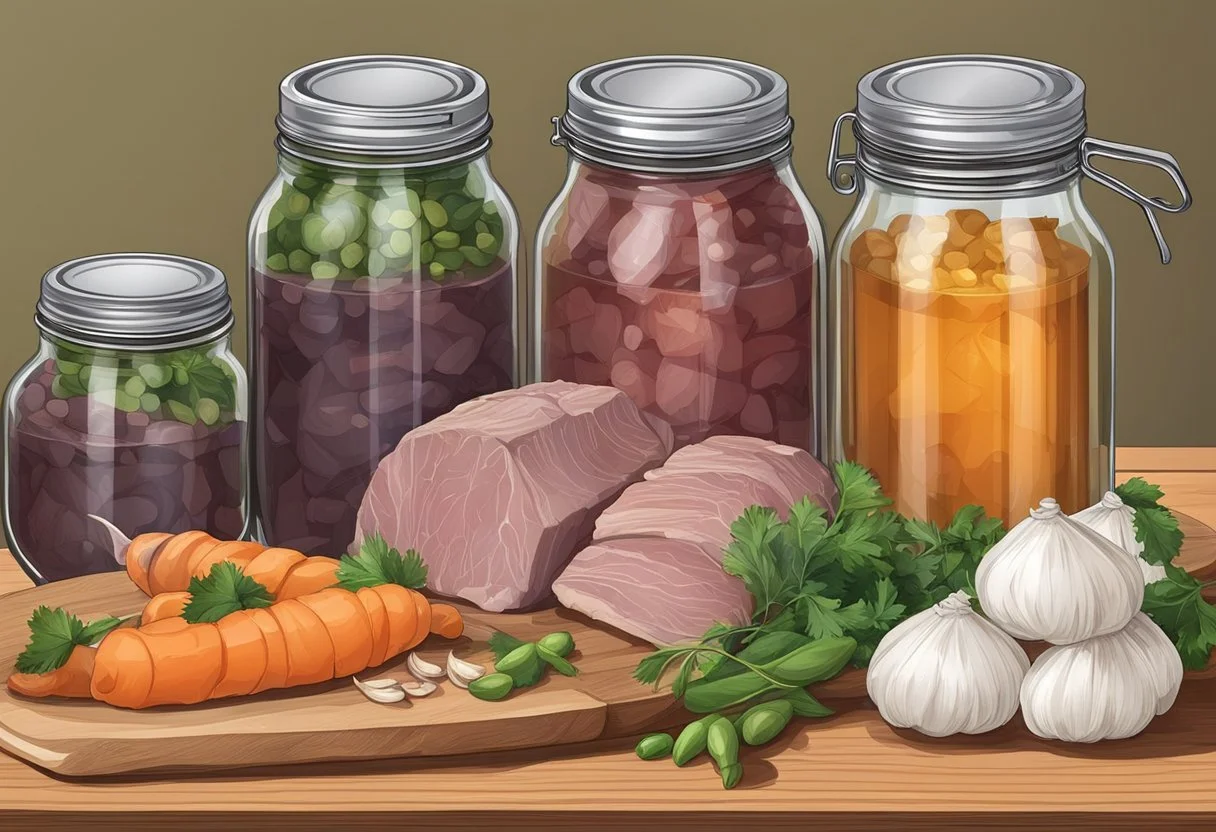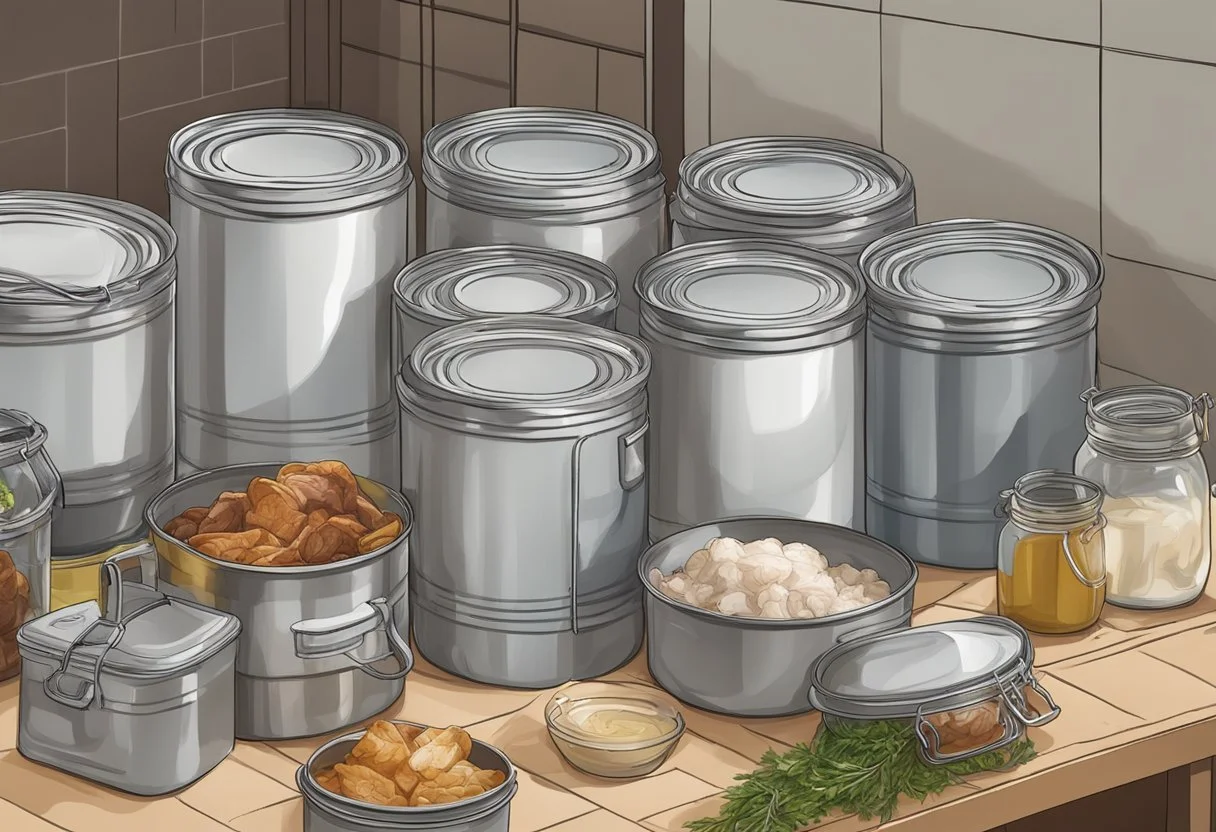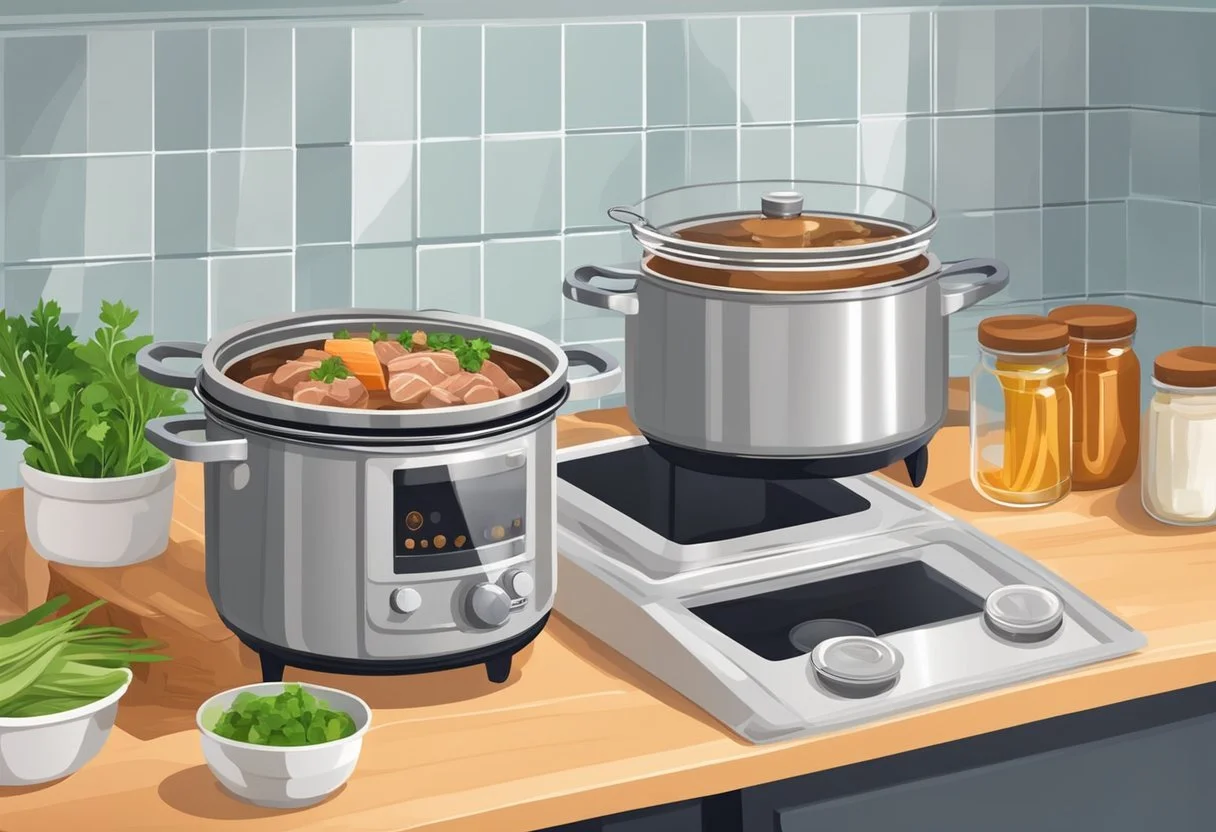Goat Meat Canning at Home
Goat meat canning at home is a practical and efficient method of preserving this nutritious source of protein. This process not only extends the shelf life of the meat but also offers a convenient alternative to refrigeration and freezing, which are both dependent on a power supply and when freezer space is always at a premium. With the right techniques and equipment, even beginners can successfully can goat meat and enjoy the benefits of having a ready-to-eat option on hand.
The process of goat meat canning typically begins with selecting high-quality meat and preparing it for preservation. It is essential to trim away any undesired parts and cut the meat into manageable pieces for the size of the jars you are using. The canning meat method used may vary depending on personal preferences and the desired end result, but most commonly, a raw pack method or a hot pack method is utilized. The hot pack method involves partially browning and cooking the meat before packing to create extra flavor before canning. Both methods involve putting the raw cubed meat into sterilized jars, along with any seasonings or broth, and then pressure canning the jars for optimal safety.
Throughout the canning process, attention to hygiene and proper techniques is crucial in ensuring a safe, delicious, and long-lasting product. Following tested recipes and guidelines will not only improve the taste of the goat but it will also significantly reduce the risk of spoilage or foodborne illnesses. By mastering the art of goat canning at home, individuals gain control over their food and achieve increased self-sufficiency in the process.
Understanding Canning and Its Types
Pressure canning is a popular method of preserving food, including goat meat, by sealing and cooking it in airtight containers, such as glass jars. This canning meat technique is highly beneficial as it allows food to be stored for an extended period without a refrigerator. Canning can be classified into two primary types: pressure canning and water bath canning.
Pressure canning is the recommended method for canning low-acid foods such as raw meat pieces, poultry, and vegetables. In this process, a pressure canner, either a dial gauge or a weighted gauge model, is used to achieve the high temperatures and pressures necessary to kill harmful bacteria and prevent spoilage. A dial gauge measures the pressure inside the canner exactly, while a weighted gauge uses a weight to regulate the pressure, as the steam escapes by slightly lifting the weight. Both techniques of pressure canning are effective in preserving low-acid foods, but they require different handling and maintenance.
On the other hand, water bath canning is suitable for high-acid foods like fruits, pickles, and jams. This method involves submerging sealed jars in boiling water to create a vacuum, eliminate the air within, and destroy any bacteria or other pathogens inside. The heat sterilizes the contents and creates a strong vacuum seal once the jars cool down.
To ensure safe and effective canned meat, the following essential canning equipment is crucial:
Canning jars: High-quality pint jars or quart jars are specifically designed for canning, such as Mason jars.
Jar lifter: A handy tool to safely lift hot jars from the canner.
Pressure canner or water bath canner: Depending on the type of food, choose the appropriate canner.
Canning lids and bands: Essential for creating an airtight seal on the jars.
Canning funnel: Assists in filling jars neatly and efficiently.
When canning goat or other low-acid foods, always opt for pressure canning as it is the safest and most effective method. Familiarize yourself with the proper usage of the canning equipment and acquire reliable recipes to ensure that your pressure canned whole foods remain safe and delicious.
Essential Canning Equipment
When goat meat canning at home, it's crucial to have the right equipment on hand to ensure a safe and efficient process. This section outlines the essential canning equipment needed for goat canned meat preservation at home.
1. Pressure Canner: A pressure canner is a must-have for pressure canning meat, such as low-acid foods like goat. Unlike a boiling water canner, a pressure canner reaches high enough temperatures and pressures to eliminate bacteria and potential toxins from the jars of meat. The All American pressure canner is a popular choice among home canners due to its durability and even heating during the canning process.
2. Mason Jars: These are the primary container for canning, and they come in various sizes to accommodate different amounts of food. Ensure you're using quart jars specifically designed for canning, as other jars may not withstand the high temperatures and pressure.
3. Lids and Rings: Canning jars require two-part lids composed of flat lids and screw bands. The flat lid has a sealing compound that ensures an airtight seal, while the screw band holds the lid in place during the cooking process. Make sure you use new lids for each batch to guarantee a proper seal.
4. Funnel: A canning funnel helps ensure that you transfer food cleanly and efficiently into the jars, minimizing spills and wastes.
5. Canning Jar Lifter: Safely handling hot jars during the canning process is essential. A jar lifter is a tool specifically designed to grasp and lift jars out of boiling water or pressure canners, reducing the risk of burns or dropped jars.
6. Plastic Utensil: A plastic utensil, such as a spatula or bubble remover, is used to remove any trapped air bubbles in the jars before sealing them. Using a non-metallic utensil prevents scratches on the jars, which could compromise the seal.
Basic Process of Goat Meat Canning
Goat meat canning is a convenient method for preserving the meat and ensuring its long-term storage, without the need for an electrical supply. Canning involves two main methods: the raw pack method and the hot pack method.
With the raw pack method, you simply raw pack goat meat and hot broth into sterilized canning jars, making the need for pre-cooking unnecessary. On the other hand, the hot pack method requires you to cook the goat meat first, for color and flavor, and then pack the browned meat into jars along with chicken broth (how long does chicken broth last?) or water.
Regardless of the method chosen, both require certain essential steps to ensure safe and effective canning. These steps are as follows:
Preparation: Ensure proper cleaning and sterilization of your canning jars and lids. This is crucial for avoiding contamination and potential spoilage.
Packing the meat: Fill the jars with the desired raw meat pieces, either raw pack or hot pack, depending on your chosen method. Add hot broth or boiling water, add salt and leave enough headspace (usually about an inch) at the top of the jar for proper sealing.
Removing air bubbles: Before sealing the jars, use a non-metallic utensil, such as a plastic spatula, to remove any trapped air bubbles. Doing this helps in preventing the jars from breaking during processing while also ensuring a proper seal.
Sealing: Wipe the jar rims with a damp cloth to remove any meat residues or liquids. Position the clean lids on the jars and screw the bands tightly to ensure a secure seal while allowing for air to escape during processing.
Pressure processing: Place the sealed jars in a pressure canner filled with the required amount of water, as per the manufacturer's instructions. Process the jars at the proper pressure level and processing time based on your altitude.
When processing goat meat, note that processing times can vary depending on factors such as jar size, meat density, and the chosen canning method (raw pack or hot pack). Follow recommended guidelines and adjust the processing time accordingly, ensuring safe and efficient preservation of your goat meat.
Adjustments for Altitude
When goat meat canning at home, it is crucial to consider the altitude at which the process is being carried out. At higher altitudes, the boiling point of water decreases, and as a result, adjustments in processing times or pressure are required to ensure effective home canning.
For those living at altitudes above 1,000 feet (305 meters), it is necessary to modify the processing times or pressure levels during the cooking process. The reason behind this is that water boils at a lower temperature at higher elevations, which may affect the proper elimination of undesired pathogens from the canned food. If these pathogens survive, they could multiply and cause sickness.
To make the necessary altitude adjustments, refer to the following guidelines:
Boiling Water Canner: Increase the processing time for every 1,000 feet above sea level:
1,001 - 3,000 feet: Add 5 minutes
3,001 - 6,000 feet: Add 10 minutes
6,001 - 8,000 feet: Add 15 minutes
Above 8,000 feet: Add 20 minutes
Pressure Canner (Weighted Gauge): Increase the pressure for every 1,000 feet above sea level:
1,001 - 3,000 feet: 10 psi for low acid foods (like goat meat), 5 psi for high acid foods
3,001 - 6,000 feet: 15 psi for low acid foods, 10 psi for high acid foods
Above 6,000 feet: 15 psi for both low and high acid foods
Pressure Canner (Dial Gauge): Increase the pressure for every 1,000 feet above sea level:
1,001 - 2,000 feet: 11 psi for low acid foods, 6 psi for high acid foods
2,001 - 4,000 feet: 12 psi for low acid foods, 7 psi for high acid foods
4,001 - 6,000 feet: 13 psi for low acid foods, 8 psi for high acid foods
6,001 - 8,000 feet: 14 psi for low acid foods, 9 psi for high acid foods
Above 8,000 feet: 15 psi for both low and high acid foods
By following these altitude adjustments to pressure canning, one can ensure a safe and successful home canning experience of goat meat, even at higher elevations.
Food Preservation and Safety Measures
Goat meat canning at home is a popular method of food preservation, especially for those who have access to fresh goat meat. When done correctly, it allows you to enjoy the taste and nutritional value of the meat for an extended period. To ensure your canned goat meat is safe and free of any potential health risks, it is crucial to adhere to the recommended guidelines and safety measures.
It's essential to understand that goat meat, like all meats, is considered a low-acid food. This classification means that it is more susceptible to the growth of Clostridium botulinum bacteria, which can cause botulism, a severe form of food poisoning. Therefore, you must follow the guidelines provided by organizations like the USDA and the National Center for Home Food Preservation.
Before canning meat, ensure proper sanitation by cleaning all work surfaces, utensils, and jars. Sterilize the jars and lids according to the Complete Guide to Home Canning guide, which can be found on the USDA's website.
When preparing the meat for canning, keep the following tips in mind:
Use only fresh, high-quality meat.
Chill the meat soon after slaughter to prevent spoilage.
If the meat cannot be canned immediately, check beforehand that you have enough freezer space, and freeze the meat until it is required and ensure it is thawed thoroughly.
To prevent the growth of bacteria, it is vital to use a pressure canner instead of a water bath canner. Pressure canners create a high enough temperature and pressure to kill the spores of Clostridium botulinum and any other harmful bacteria. Strictly follow the processing time, pressure levels, and other instructions mentioned in the Complete Guide to Home Canning for goat meat canning and any meat in general.
After the cooking process of ground meat is complete, let the jars cool down at room temperature, and avoid touching the lids for 12-24 hours. Double-check that the lids are properly sealed and that there is no leakage. Store the canned goat meat in a cool, dark, and dry place with temperature ranging between 50 and 70°F to ensure the maximum shelf life.
In conclusion, goat meat canning at home can be a rewarding way to preserve food for later use. By following the guidelines and safety measures provided by the USDA and the National Center for Home Food Preservation, you can ensure a safe and enjoyable eating experience.
Different Types of Meat Suitable for Canning
Home canned meat is a great way to preserve various types of proteins for long-term storage. While this article focuses on canning goat, it's important to know that there are several other canning meat options that work well with this method. Here's a brief overview of different meats that can be successfully canned at home.
1. Beef: Canning beef at home is a great storage method, with different cuts like chuck, round, and sirloin tips being the most suitable. Canning beef that has been ground works well too, provided that the excess fat is trimmed off and beef stew (What wine goes well with beef stew?) cans well too.
2. Pork: Another common choice for home canning is pork. Raw meat lean cuts such as loin, shoulder, and ham work best. Ground pork m can also be canned after removing excess fat.
3. Poultry: Canning chicken and turkey are both excellent options. They can be canned either bone-in or boneless, with the skin removed to minimize the fat content.
4. Venison (What wine goes well with venison?): Strong flavored wild meats, derived from deer, and other wild game can be safely canned at home, offering a tasty alternative to traditional meats. With canned venison always trim off and remove excess fat, and sinew from the wild game before canning meats.
5. Elk, Moose, and Bear: These other game meats are also suitable for canning, providing an opportunity to preserve these less common, strong flavored wild meats, which are a good source of nutrient-rich proteins. As with other canned meat, ensure that all excess fat and sinew are removed from deer meat before canning.
In summary, various types of meat can be canned at home, ranging from traditional options like beef and pork to game meats such as venison, elk, moose, and bear. When canning meat, it's essential to trim off any excess fat and clean the canning meat properly to ensure its safe preservation.
Flavor and Quality of Canned Meat
When it comes to canned goat meat, the taste and quality largely depend on the process and ingredients used during canning. Properly canned goat meat retains its tenderness and juiciness, while also absorbing the flavors of added seasonings.
In terms of taste, canned meat usually takes on a rich, savory flavor profile. Moreover, the process enhances the meat's natural flavor, giving it a distinct taste that sets it apart from fresh or frozen cuts.
Canning meat well gives a characteristic pink color to the meat that it maintains even after canning. This is a result of the adequate heating and pressure canning methods employed. The presence of a uniform and appealing hue indicates thorough processing for both safe consumption and optimal palatability.
To achieve high-quality canned meat products, consider the following aspects:
Meat quality: Select the freshest and best quality goat meat available. Avoid cuts with excess fat or gristle for a better overall flavor and texture.
Seasonings: Choose your preferred seasonings, such as salt, spices, and herbs, to enhance the taste of the canned meat. Be mindful of the quantities used to avoid overpowering the meat's flavor.
Canning technique: Use a pressure canner to ensure the meat reaches a sufficient temperature to eliminate any harmful microorganisms. This also helps to maintain the meat’s quality, texture, and taste.
Storage: Store canned meat in a cool, dark environment to prolong its shelf life and preserve its flavor for future consumption.
Overall, the flavor and quality of canned goat meat are largely influenced by factors such as meat quality, seasonings, canning techniques, and storage conditions.
Harvesting and Goat Meat Canning
Once the goat has been humanely harvested, the process of butchering can begin. Make sure to properly clean, and trim the meat, removing any excess fat or undesired tissue. For canning purposes, we recommend cutting the goat meat into one-inch cubes, as these sizes work best for this preservation method.
Before canning meat, gather all essential equipment such as a pressure canner, quart jars, and lids. Be sure to sterilize each quart jar and lid to avoid any contamination. Also, set aside some uniodized salt, which adds flavor to the canned meat, though it is optional.
When it comes to canning goat, the raw pack method is both easy and reliable. To use this method:
Pack the raw goat meat into each quart jar: Tightly pack each sterilized quart jar with the trimmed cubed meat, leaving 1-inch headspace at the top. Optionally, add 1/2 to 1 teaspoon of salt per pint jar prior to filling with meat.
Wipe the rims: Use a clean cloth to wipe the rim of each quart jar, ensuring a good seal.
Secure the lids: Place a sterilized lid on each quart jar and tighten the screw bands.
Pressure can the jars: Place the jars in the pressure canner, securing the lid on the canner. Follow the manufacturer's instructions regarding the pressure and processing time. Typically, pressure cook pint jars at 11-15 lbs pressure for 75 minutes and quart jars at 11-15 lbs pressure for 90 minutes, depending on your altitude.
Cool and store: Once the processing time is up, turn off the heat and allow the canner to depressurize completely before opening. Remove the hot jars and let them cool for 12-24 hours. Check the seals and store the jars in a cool, dark place.
Useful Tools and Resources for Canning
When it comes to goat meat canning at home, there are a number of useful tools and resources available to ensure a safe and successful process. First and foremost, conducting research on proper canning techniques is essential. The National Center for Home Food Preservation is an excellent resource that provides in-depth information related to canning safety and instructions.
To embark on the canning journey, you will require specific equipment. Some essential canning tools include:
Pressure canner
Jars with lids and bands
Jar lifter
Funnel
Lid wand
Bubble remover or non-metallic spatula
It is important to note that a pressure canner is the only safe method for canning low-acid foods like meats. Additionally, using reputable brand equipment like the Presto pressure canner can contribute to better results and assurance of safety.
Canning guides are also available to help you at each step of the process. These guides typically cover topics such as selecting ingredients, preparing jars, and processing times. A variety of canning recipes can be found in books, online resources, or through knowledgeable friends and family.
The following resources provide great starting points for canning recipes:
While the focus may be on canning meat, consider expanding your knowledge to include vegetable canning recipes and canning soups. The science of canning different types of food varies, and having a well-rounded understanding can improve your overall canning experience.
Canning Other Foods
In addition to canning fish and goat, you can also preserve a variety of fruits, vegetables, and other foods using home canning methods. Some popular options include tomatoes, peppers, apples, pears, cucumbers, and more. By canning these foods, you can extend their shelf life and enjoy them throughout the year.
Fruits can be canned as jams and jellies, which are excellent ways to retain the flavors of your favorite fruits, including apples and pears. A basic jam recipe consists of fruit, sugar, and a pectin (how long does pectin last?) source for thickening. Jellies, on the other hand, use fruit juice, sugar, and pectin to create a clear, spreadable food product.
For vegetables, options range from canning whole or chopped vegetables, such as tomatoes, or tomato juice to creating pickles and relishes. You can also try preserving cucumbers using fermentation, resulting in a tangy, crunchy snack known as sauerkraut (how long does sauerkraut last?). Fermented foods (What wine goes well with fermented foods?) like sauerkraut and pickles offer additional health benefits due to their probiotic properties.
Here's a list of common foods that can be canned:
Tomatoes
Peppers
Apples
Pears
Cucumbers
Jams
Jellies
Sauerkraut
Fermented foods
Tomato juice
Canning also allows you to create various mixtures and blends like salsa and pasta sauce (how long does pasta sauce last?), giving you the freedom to experiment with flavor combinations in all the recipes. It is important to follow canning instructions carefully to ensure food safety and avoid spoilage. Proper canning techniques will help you enjoy your favorite fruits, vegetables, and other foods in an instant pot without worrying about their freshness and as an alternative preservation method to store food it saves on freezer space.






